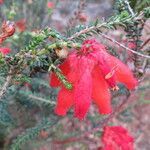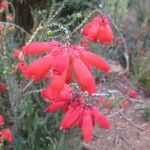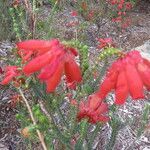Erect, 2-3 ft. high; branches ascending, often virgate and simple; leaves 4-5-6-nate, from erect and closely imbricate to spreading, squarrose or recurved, linear or linear-lanceolate, blunt, deeply sulcate to sub-open-backed, variably pubescent and mostly glandular, hispid and ciliate, more rarely glabrous and naked, 3-8 lin. long by 1/3-1/2 lin. wide; flowers umbellate; pedicels glabrous or pubescent, 1-6 lin. long; bracts approximate, or one subremote, linear-lanceolate, oblong or lanceolate, acute or subobtuse, gland-hispid and ciliate, about 2 lin. long; sepals like the bracts but larger, from 2-3 1/2 lin. long; corolla tubular, more or less inflated, slightly constricted at the mouth, more or less pubescent, usually both shortly so and also pilose with longer (sometimes glandular) hairs, mostly crimson, more rarely rosy, 1/2-1 1/3 in. long; limb spreading or erect; anthers included, dorsifixed just above the base, oblong, pallid, about 1 lin. long, mutinous or with very short or rudimentary minute horns; style included or exserted; ovary broadish turbinate, villous.
Resprouting, compact shrub with woody base, 0.3-0.9(-2.0) m high. Leaves 3-6-nate, closely overlapping, spreading or recurved; blade needle-like, 5-17 x 1 mm, glandular, deeply sulcate or subopen-backed. Flowers in compact terminal clusters, umbellate. Calyx sepals 4-7 mm long, bract-like but larger, densely glandular-hairy. Corolla tubular, ± inflated, slightly constricted at mouth, ± pubescent, crimson, dark pinkish red, orange-red or white with red apex; lobes spreading, obtuse. Anthers included, oblong; appendages short or minute; pore 1/2 length of theca. Ovary broadish turbinate, villous; style included or exserted; stigma capitate. Flowering time all year.
A shrub. It has a woody base and stems up to 30 cm high. The leaves are about 5 mm long. The flowers are in close clusters at the ends of the branches. The flower tubes are 3.5 cm long. They are usually white and spread slightly at the ends.
Erect, resprouting shrub, mostly compact to 30 cm, sometimes sparse to 1.2 m. Flowers large, tubular-inflated, orange-red, hairy.



